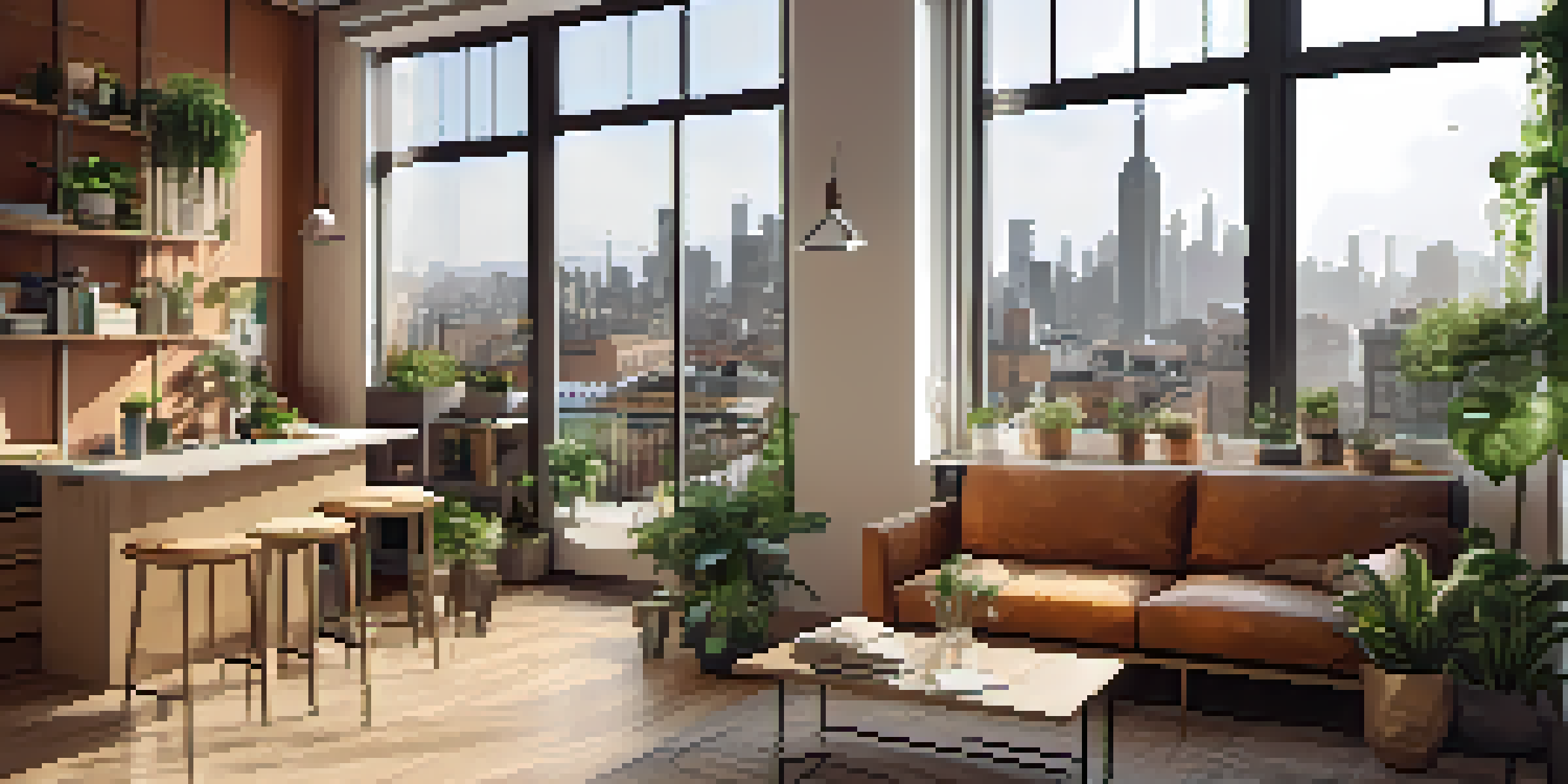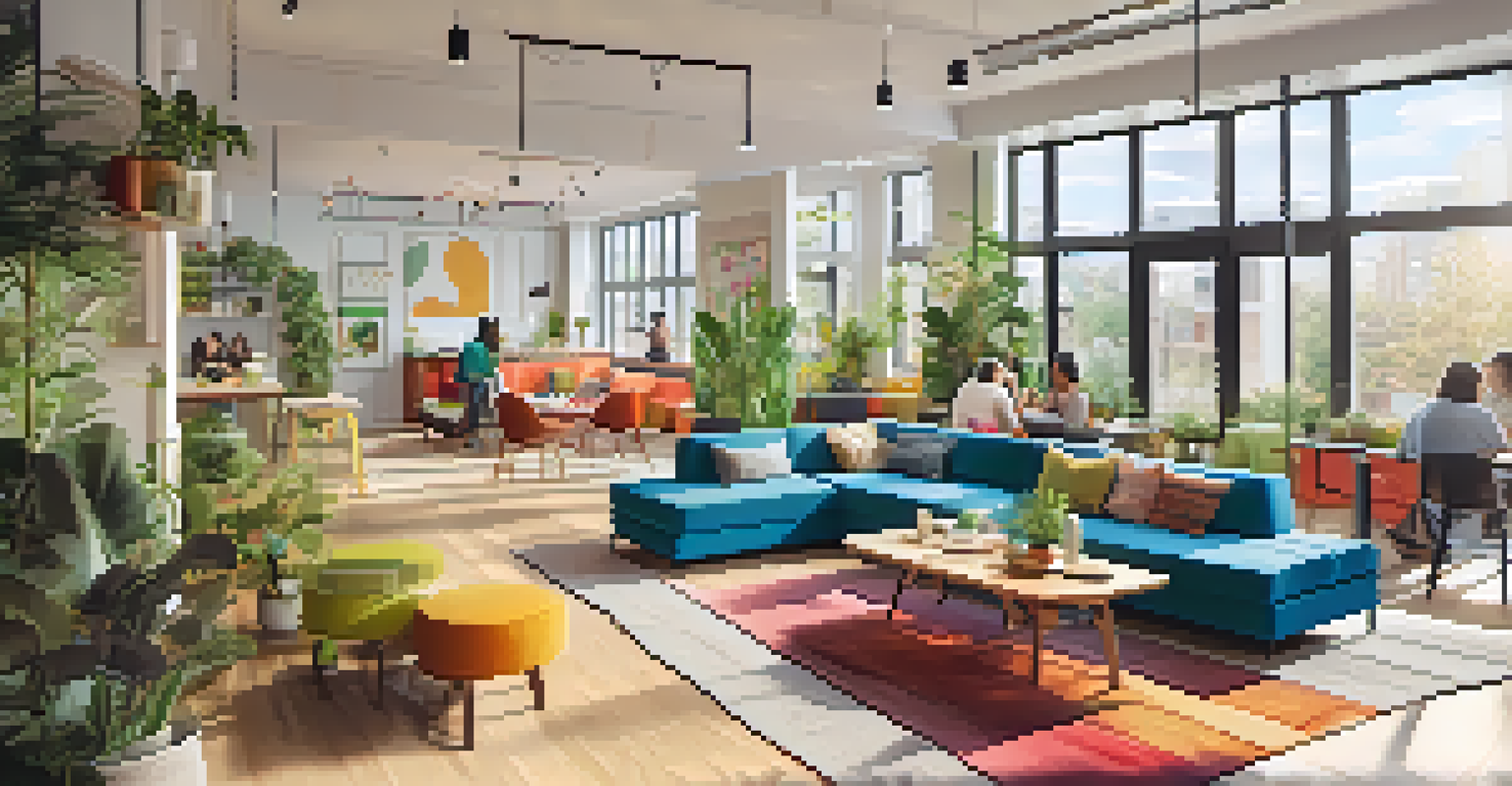The Rise of Micro-Apartments in Urban Living Spaces

Understanding Micro-Apartments and Their Appeal
Micro-apartments are compact living spaces typically ranging from 200 to 400 square feet. They often feature multifunctional furniture and smart design to maximize usability. The appeal lies in their efficiency and affordability, particularly in urban areas where space is at a premium.
Living in a small space can lead to a greater appreciation for the things you have and the experiences you create.
As cities grow, the demand for housing increases, leading to skyrocketing rents. For many young professionals and students, micro-apartments provide a viable solution, allowing them to live closer to work or school without breaking the bank. This trend not only makes urban living more accessible but also encourages a minimalist lifestyle.
Moreover, micro-apartments often come with shared amenities, such as communal kitchens and lounges, fostering a sense of community. This combination of private and shared spaces creates a vibrant living experience, ideal for those who thrive in social environments.
The Benefits of Living in Micro-Apartments
One of the primary benefits of micro-apartments is cost savings. With lower rent and utility costs, residents can allocate their budgets towards experiences and savings rather than just housing. This financial flexibility is a significant draw for many urban dwellers.

Additionally, micro-apartments promote a decluttered lifestyle. With limited space, residents tend to own fewer possessions, leading to a more organized and simplified living environment. This shift can reduce stress and enhance overall well-being.
Micro-Apartments: Affordable Urban Living
Micro-apartments offer a cost-effective housing solution in urban areas, appealing to young professionals and students.
Lastly, the design of micro-apartments often encourages creativity in how residents utilize their space. From convertible furniture to innovative storage solutions, living in a micro-apartment can inspire a unique approach to home decor and functionality.
Challenges Faced by Micro-Apartment Residents
Despite their many advantages, micro-apartments come with challenges. The limited space can lead to feelings of confinement, especially for individuals who are used to larger living areas. Adapting to such a small footprint requires a significant mindset shift.
The best way to predict the future is to create it.
Privacy can also be an issue, particularly in buildings with shared amenities. While communal spaces foster community, they can also intrude on personal time and space. Finding a balance between social interaction and solitude becomes critical.
Lastly, the lack of traditional storage can be frustrating for residents who have more belongings than the space allows. Creative organization becomes essential, and some may find themselves needing to downsize or frequently reassess their possessions.
The Role of Technology in Micro-Apartments
Technology plays a pivotal role in enhancing the micro-apartment living experience. Smart home devices, for instance, can optimize space management, allowing residents to control lighting, temperature, and security with ease. This convenience can make small living spaces feel more comfortable and efficient.
Additionally, many micro-apartments incorporate innovative design technologies. From modular furniture that can adapt to different needs to built-in storage solutions, these advancements help residents maximize every square foot of their home. This tech-savvy approach is appealing to a younger, urban demographic.
Community and Shared Spaces Thrive
These living spaces often include shared amenities that foster a sense of community among residents.
Furthermore, the rise of co-living platforms connects micro-apartment residents, providing them with opportunities for networking and community engagement. These platforms often include features like shared events and online forums, enhancing the sense of belonging among residents.
The Impact of Urbanization on Micro-Apartment Demand
Urbanization is a driving force behind the rise of micro-apartments. As more people flock to cities for job opportunities and lifestyle, the demand for affordable housing intensifies. Micro-apartments emerge as a solution, catering to the needs of urban dwellers seeking convenience and accessibility.
This trend is particularly evident in metropolitan areas where traditional housing options may be limited or excessively priced. Developers are increasingly recognizing the value of micro-apartments in addressing housing shortages, leading to more projects focused on this market.
Moreover, urbanization often leads to a shift in lifestyle preferences. With a growing emphasis on walkability and access to public transport, many individuals prioritize location over size, making micro-apartments an attractive option for those who want to live in vibrant city centers.
Future Trends in Micro-Apartment Development
The future of micro-apartments looks promising, with expected innovations in design and technology. Developers are likely to explore sustainable building practices, integrating eco-friendly materials and energy-efficient systems to appeal to environmentally conscious consumers. This aligns with the growing trend of sustainability in urban living.
Additionally, as remote work becomes more prevalent, micro-apartments may evolve to accommodate home office spaces. Flexible layouts that allow for work-from-home setups could enhance the appeal of these compact living spaces, attracting a broader audience.
Future Trends: Sustainable Innovations
The micro-apartment sector is expected to evolve with sustainable building practices and flexible layouts for remote work.
Finally, the concept of community-oriented micro-apartments may gain traction. Developers might focus on creating environments that encourage social interaction and collaboration, integrating shared spaces and programs that foster a sense of belonging among residents.
Conclusion: Embracing the Micro-Apartment Lifestyle
The rise of micro-apartments represents a significant shift in urban living trends. By prioritizing efficiency, affordability, and community, these compact spaces cater to the evolving needs of city dwellers. For many, embracing the micro-apartment lifestyle is not just about living small; it’s about living smart.
As cities continue to evolve and grow, micro-apartments will likely play a crucial role in shaping the future of urban housing. Their ability to blend functionality with modern design makes them an attractive option for a diverse range of residents.

Ultimately, whether you're a young professional, a student, or someone seeking a minimalist lifestyle, micro-apartments offer a unique solution to urban living challenges. By embracing these small spaces, residents can experience the vibrancy of city life without the constraints of traditional housing.